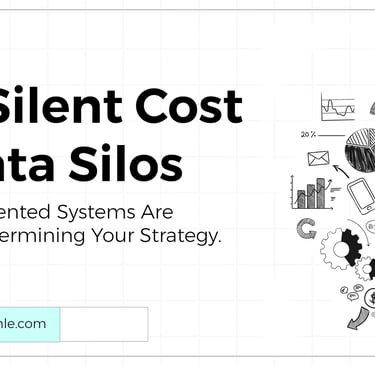The Silent Cost of Data Silos
Many enterprises in Africa are unknowingly leaking revenue and time due to fragmented data systems. This article explores the unseen cost of data silos and how business leaders can address it.
BUSINESS INTELLIGENCE
Oluwatayo Winkunle
7/16/20253 min read


Let’s be honest - everyone’s saying the right things in board room and management meetings:
“We want to become more data-driven.”
“We’re investing in AI.”
“We just signed off on a new reporting tool.”
"Digital transformation is top priority"
But day-to-day, it still feels like something’s off. There’s hustle, yes. But very little clarity. That “something” that’s dragging your execution? It’s DATA SILOS.
The Invisible Drain on Enterprise Performance
Data silos are when departments operate on separate, unconnected systems, making it difficult or impossible to get a unified view of the business. On paper, it sounds like an IT issue. In reality, it’s a strategic failure.
Let’s bring it home.
Your marketing team is measuring campaign performance on Google Analytics.
Your sales team logs leads in Excel.
Your customer service logs issues in a CRM that no one else can access.
Finance pulls reports from an ERP that’s two steps removed from real-time operations.
Now multiply that across 5 departments and 3 business units.
Everyone is “busy”. But no one sees the full picture. That’s the silent cost.
Data silos don’t show up on your balance sheet. They don’t beep. They don’t crash servers. They just quietly slow you down until your teams are spending more time aligning spreadsheets than making decisions. They weren’t disorganized. They were just fragmented. And in that fragmentation, they lost both time and trust.
You Can’t Fix What You Can’t See
Siloed data systems create operational blind spots that compound over time:
Delayed decisions - when your leadership team can’t get performance insights quickly, decisions are based on gut, not ground truth.
Duplicated effort - teams are rebuilding what already exists elsewhere. You just don’t know it.
Revenue leakage - whether in missed follow-ups, faulty forecasts, or late proposals, money is quietly bleeding out.
We’ve seen it play out in banks where customer engagement data sits in one unit while product performance lives in another. Or in energy companies where logistics and billing systems don’t sync - delaying invoicing for services already rendered.
No alarms. Just friction.
This Isn’t an Ops Problem. It’s a Leadership One.
Many execs assume that buying new software will solve this. But digital tools don’t fix fragmentation. They amplify it. If your structure is siloed, new tools will just help each silo move faster. Alone.
The real issue?
Departmental data ownership without alignment
Lack of cross-functional accountability
Absence of executive-level data integration mandates
This is why enterprise intelligence cannot be delegated solely to the IT or data team.
It needs boardroom-level visibility and urgency.
You Can’t Build Intelligence on Fragmentation
Everyone’s talking about AI and rightly so. But here’s the truth: AI is a mirror. If you feed it chaotic, inconsistent, or siloed data, it will reflect that chaos back. You won’t get insight. You’ll get noise.
Enterprise intelligence isn’t just about collecting more data - it’s about unlocking what you already have and making it flow. Until your systems speak to one another, your teams won’t either.
What You Can Do, Starting This Week
If you’re in leadership, here are 5 starting points:
Map your data environment. Where does data live? What’s connected? What’s isolated?
Push for aligned KPIs across departments. Shared goals naturally encourage shared data.
Fund integrations, not just new dashboards. Insight isn’t built on visualizations; it’s built on connected systems.
Create a governance structure. Data ownership needs to be defined and enforced at the executive level.
Ask better questions. Not “what does the dashboard say?” but “can I trust where this data came from?”
Closing Thought
Your business is already generating intelligence; every campaign, every transaction, every client conversation. The question is: can your systems surface that intelligence when it matters most?
Data silos won’t make the news. They won’t bring down your business overnight. But left unchecked, they’ll quietly erode your speed, alignment, and performance.
And in a world moving this fast, quiet erosion is how transformation fails.